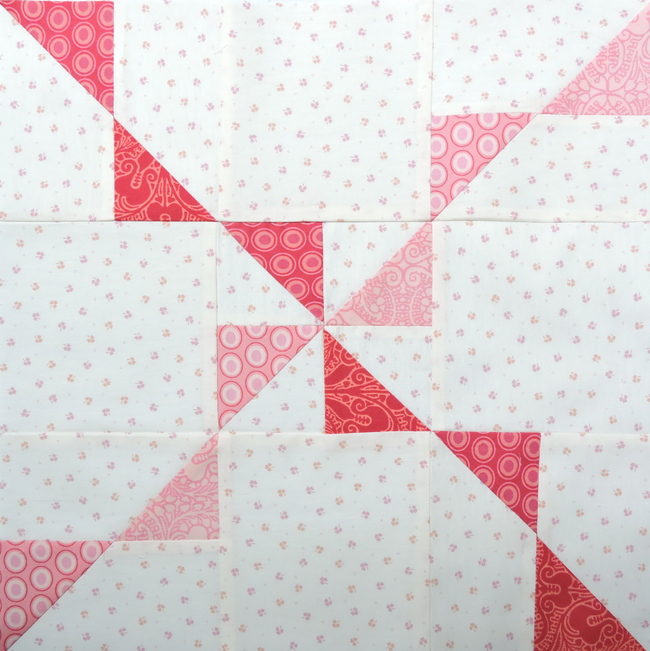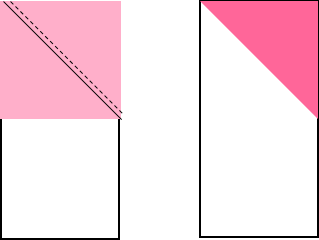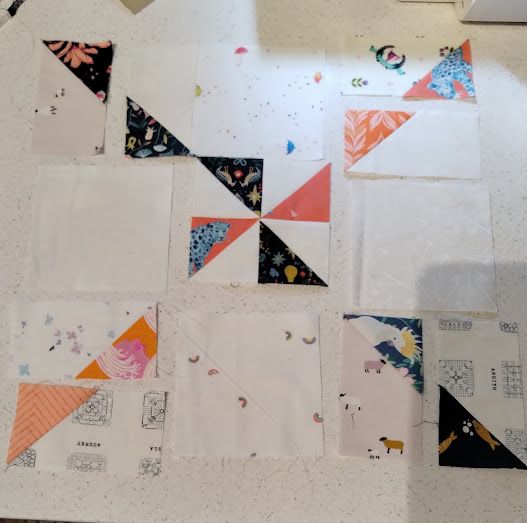Hi busy Hive 1 Bees,
Last year, I chickened out of posting a Foundation Paper Piecing (FPP) Pattern.
I hope, this year, you are as brave with this, as me! – I present: The ‘Diamond Star’!
Recently I got interested in 1950’s and 1960’s fabric/wallpaper patterns (during a search for fabric for a quilt I’m making for a friend) and quickly realized, that some of those patterns would be fun to create in patchwork. So, I dabbled in drafting a few FPP patterns. That’s where this block springs from.
For those of you who are not comfortable with FPP, I’ve put basic instructions below, on how I approach this. I would encourage you to check out a few online tutorials. Here are a couple of links to videos I found very helpful:
Violet Craft ,
Sheri Cifaldi-Morrill (On this one, the fun starts at about 8 minutes in.)
However, people are all different, so if these methods do not suit you after you’ve tried them – don’t give up! There are plenty of other (video) tutorials on the www!
For all those who do FPP in their sleep:
If you rather wing it with your own method, go for it!
The block I am asking you to do comes (and stays!) in 4 parts, which are Right Triangles, that all finish 9 11/16 “ x 7 5/16 “ (incl. Seam Allowance). Don’t worry – you will not have to measure for trimming! That is what the template is for.
However: I can only ask you to sew two of the templates, as all 4 of them would exceed the number of pieces allowed in a Paper Piecing pattern for StashBee. You are welcome to make all 4 templates, but it is not a requirement.
If you decide to only make 2 of the templates, please enclose the fabric pieces for the remaining 2 parts, so I can complete the block. Thank you.
Please sew on 2 of the templates, but
do not sew them together and do not take off the paper. Thanks!
The pattern comes in 4 pieces, where Part A and Part B are the same, and Part C and Part D are the same and those are mirror images of A and B.
Foundation Paper Piecing is a method where fabric is sewn on to paper (template), with the printed lines on the paper template being the sewing lines and outline the areas that are covered by the different fabric pieces.
Note that the fabric is sewn to the blank side of the paper template, with the wrong side of the fabric facing the blank side of the paper template. Therefore, the final result of the fabric block is a mirror image of the printed image on the paper template.
As in normal piecing, all fabric pieces are sewn together with right sides of fabric together.
This can be a bit confusing for beginners, as you have to keep the paper template in mind at the same time. Using solid fabric (which has no right or wrong side) helps here.
Fabric Choice and Cutting Instructions:
Please cut the fabric for all 4 template pieces, although you will only sew with half of them. Please enclose the remainder in the post to me. Thank you!
The Fabric placement on all 4 pattern pieces is the same. See the diagram below.

For Foundation Paper Piecing you’ll also need:
• the Paper Template and
• either some glue stick or pins to hold the first fabric piece in place.
I personally prefer glue, as the pins get in my way, when I pre-cut the seam allowance.
FPP Template:
Here the Link to the Template PDF (2 pages): Diamond Star FPP Pattern
Please print this at ‘Actual Size’ or ‘100%’!
On both pages is a Test Square: when printed at the correct size, this should measure 1” on the sides.
In order to make 2 of the pieces, you only need to print one of the pages!
Cut out the 2 templates. I find it useful, to leave a little bit of space around the dotted lines, as those are the trim lines for later.
Instructions for covering one of the templates (repeat for 2 of them in total):
For one template you need:
Step 1: Temporarily attach the first two fabric pieces to the paper template.
Use either a dab of glue or a pin to hold the first fabric piece (Right Side Up) in place on the un-printed side of the template, so that it covers area 1 including ¼” seam allowance all around.
Step 2: Sew Areas 1 & 2 fabrics to the template.
Turn the template over to show the printed side, and fold the paper back along the sewing line between areas 1 and 2. Cut the seam allowance on the fabric back to ¼” along the paper fold.
Align the fabric piece for area 2 with right sides facing to the fabric already attached to the template, along the just created seam allowance, so that area 2 is fully covered plus ¼” seam allowance all round. Hold in place with a pin or clip.
At your sewing machine:
Reduce your stitch length to ca. 1.5 – this ensures, the stitching will act as perforation for the paper and also sturdy seams.
Put the template with the printed side up under your sewing needle, take out/away the pin/clip, making sure the fabric doesn’t slide. Fold down the paper. Sew along the line between areas 1 and 2, including at least ¼” beyond the sewing line intersection with the other sewing lines.
Fold back and finger press the area 2 fabric.
Step 3: Sew Area 3 Fabric to the template.
Carefully pull the new seam from the paper to expose the intersection of the seam lines between areas 1 / 2 and 3. Turn the template over to show the printed side and fold the paper back along the seam lines between areas 1 / 2 and 3. Trim the fabric to a seam allowance of ¼” along this fold.
Align the fabric piece for area 3 with right sides facing to the fabric already attached to the template, along the just created seam allowance, so that area 3 is fully covered plus ¼” seam allowance all round. Hold in place with a pin or clip.
Go to your sewing machine and sew on the seam line between areas 1 / 2 and 3.
Fold back and finger press the area 3 fabric.
Step 4: Sew Area 4 Fabric to the template.
Turn the template over to show the printed side and fold the paper back along the seam lines between areas 3 and 4. Trim the fabric to a seam allowance of ¼” along this fold.
Align the fabric piece for area 4 with right sides facing to the fabric already attached to the template, along the just created seam allowance, so that area 4 is fully covered plus ¼” seam allowance all round. Hold in place with a pin or clip.
Go to your sewing machine and sew on the seam line between areas 3 and 4.
Fold back and finger press the area 4 fabric.
Step 5: Sew Area 5 Fabric to the template.
Turn the template over to show the printed side and fold the paper back along the seam lines between areas 4 and 5. Trim the fabric to a seam allowance of ¼” along this fold.
Align the fabric piece for area 5 with right sides facing to the fabric already attached to the template, along the just created seam allowance, so that area 5 is fully covered plus ¼” seam allowance all round. Hold in place with a pin or clip.
Go to your sewing machine and sew on the seam line between areas 4 and 5.
Step 6: Trim the template.
Now all the template areas are covered with fabric,
give it a quick press – on the fabric side only.
Then trim the template along the dotted outer line.
Repeat the Steps 1 to 6 for one of the other 3 templates.
Below my sample blocks in the two colour combination choices: in darker/lighter colour and in darker colour plus black.
Thank you all for sewing for me!
If you have any questions, please send me an email.
Happy sewing,
Rita.


























































